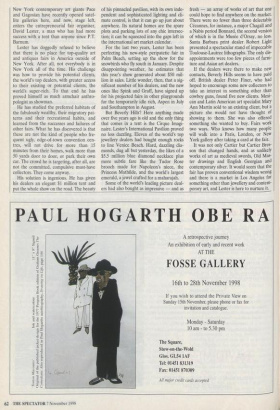Salerooms
The show's on the road
Susan Moore
There was no parade of elephants down Wilshire Boulevard, more's the pity. But the Big Top was up in Beverly Hills, hoist- ed above the Robinsons May parking lot. Inside there were attractions to rival those a block away on shopping-paradise-on- earth, Rodeo Drive. Banners lined the streets and the barkers had been busy, but what would LA make of its first ever major international art and antiques fair?
No one had ever got the fair formula right in Los Angeles — the right venue, the right dealers; the right ambience, the right crowd. The art industry has been slow to tap the resources of America's second largest city, despite its wealth of serious collectors and a GNP in California about the size of that of France. LA has had no real infrastructure of big dealers, fairs or important sales — but that is all changing. New York contemporary art giants Pace and Gagosian have recently opened satel- lite galleries here, and now, stage left, enters the entrepreneurial fair organiser, David Lester, a man who has had more success with a tent than anyone since P.T. Barnum.
Lester has doggedly refused to believe that there is no place for top-quality art and antiques fairs in America outside of New York. After all, not everybody is in New York all of the time. His challenge was how to provide his potential clients, the world's top dealers, with greater access to their existing or potential clients, the world's super-rich. To that end he has proved himself as much armchair anthro- pologist as showman.
He has studied the preferred habitats of the fabulously wealthy, their migratory pat- terns and their recreational habits, and learned from the successes and failures of other fairs. What he has discovered is that these are not the kind of people who fre- quent ugly, edge-of-town convention cen- tres, will not drive for more than 15 minutes from their homes, walk more than 50 yards door to door, or park their own car. The crowd he is targeting, after all, are not the committed, compulsive must-have collectors. They come anyway.
His solution is ingenious. He has given his dealers an elegant $1 million tent and put the whole show on the road. The beauty of his pinnacled pavilion, with its own inde- pendent and sophisticated lighting and cli- mate control, is that it can go up just about anywhere. Its natural homes are the spare plots and parking lots of any chic intersec- tion; it can be squeezed into the gaps left in the international art market calendar.
For the last two years, Lester has been perfecting his new-style peripatetic fair in Palm Beach, setting up the show for the snowbirds who fly south in January. Despite disappointing weather, he estimates that this year's show generated about $50 mil- lion in sales. Little wonder, then, that a sig- nificant number of his dealers, and the new ones like Spink and Graff, have signed up for his projected fairs in other playgrounds for the temporarily idle rich, Aspen in July and Southampton in August.
But Beverly Hills? Here anything made over five years ago is old and the only thing that comes in a tent is the Cirque Imagi- naire. Lester's International Pavilion proved no less dazzling. Eleven of the world's top jewellery dealers had bought enough rocks to line Venice Beach. Hard, dazzling dia- monds, dug all but yesterday, the likes of a $5.5 million blue diamond necklace plus more subtle fare like the Tudor Rose brooch made for Napoleon's niece, the Princess Mathilde, and the world's largest emerald, a jewel crafted for a maharajah.
Some of the world's leading picture deal- ers had also bought as impressive — and as fresh — an array of works of art that one could hope to find anywhere on the market. There were no fewer than three delectable Cezannes, for instance, a major Chagall and a Nabis period Bonnard, the second version of which is in the Musee d'Orsay, no less. Santa Barbara print dealer Robert Light presented a spectacular stand of impeccable Toulouse-Lautrec lithographs. The only dis- appointments were too few pieces of furni- ture and Asian art dealers.
If the dealers were there to make new contacts, Beverly Hills seems to have paid off. British dealer Peter Finer, who had hoped to encourage some new collectors to take an interest in something other than cowboy guns, found five new clients. Mexi- can and Latin American art specialist Mary Ann Martin sold to an existing client, but a picture she would not have thought of showing to them. She was also offered something she wanted to buy. Fairs work two ways. Who knows how many people will walk into a Paris, London, or New York gallery after taking a card at the fair.
It was not only Cartier but Cartier Bres- son that changed hands, and as unlikely works of art as medieval swords, Old Mas- ter drawings and English Georgian and contemporary silver. It would seem that the fair has proven conventional wisdom wrong and there is a market in Los Angeles for something other than jewellery and contem- porary art, and Lester is here to nurture it._



















































































 Previous page
Previous page